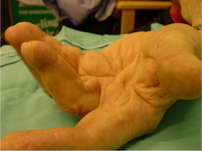


| Home | : | Biography | : | Fellowships & Awards | : | Publications | : | : | Mediation | : | Useful Links | : | Contact |
 Dupuytren's disease was first described in 1831 by Baron Gauillaume Dupuytren, a French Surgeon. He described 'permanent retraction of the fingers' attributed to tightness of the palmar fascia. Dupuytren contracture is a progressive disease involving thickening of the superficial tissues in the palm of the hand (called the palmar fascia) which extends up all four fingers and thumb. Initially the disease starts with nodules in the palm of the hand, over the base of the finger which can be tender. This tenderness abates and essentially Dupuytren's is a painless condition. As the tissues thicken they also contract, a little bit like a scab on the back of a hand. As they contract the finger is gradually drawn in towards the palm.  The fingers most frequently involved are the ring and little fingers, followed by the middle finger and the thumb. Involvement of the index finger is infrequent, although it can occur. The disease can also give lumps over the back of the hand over the back of the proximal interphalangeal joint (PIPJ). These are called Garrods pads.  Incidence Dupuytren's contracture is a common condition. It is more common in men than women (6-1) and more common in ages between fifty and seventy years. It is more common in Northern Europe and it is believed that the Vikings brought the disease into our country. It is present in both hands in approximately 65% of cases. |
|
